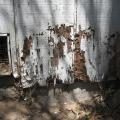What to Do If You Find a Carpenter Bee Hole
Carpenter bees are easy to identify. Although they look like other bees they are black, some have a small yellow stripe on their back. They are also more solitary than other bees and generally won’t attack unless you provoke them.
However, unlike most bees, carpenter bees have earned their name through their love of wood. They will drill a hole into the wood in order to create a spot to lay eggs. As they create a passage in the wood they will lay eggs in small side passages along the way. This spreads risk and helps to ensure they survive.
Unfortunately, this means they can do a significant amount of damage to any wooden structure, although maybe not as much damage as termites. While carpenter bees will often target dead wood or bamboo, they will also attack hardwoods and even softer ones such as pine.
This means you are likely to find a carpenter bee or two making a home in your home. It’s worth noting that pressure-treated wood can still be attacked by a carpenter bee.
Get Professional Help
There may only be one bee and you may feel brave enough to take it on. But, the sting will still hurt you. The safest course of action, especially if you suffer from allergies, is to use your local pest control company.
It’s worth noting that male carpenter bees don’t have a stinger, although they can appear aggressive. Of course, it can be hard to tell if you're dealing with a male or female carpenter bee!
Pesticide
As mentioned, it is best to get pest control to deal with your carpenter bee. They will check for other bees in the area and make sure your whole house is clear.
But, if you feel the need to deal with the issue yourself then take a look at the holes you’ve found. A carpenter bee creates a ¼ inch thick hole. Once they are in the wood their tunnel will go with the grain.
If there is noise from the hole or sawdust emerging then the carpenter bee is currently active inside. Spray a pesticide into the hole that is designed to kill bees. The bee will reappear quickly but die shortly after coming into contact with the pesticide.
You can then check for more holes and activity. Mark each one you’ve treated.
Seal the Hole
Once the bee is out you’ll need to seal each of the holes. It’s best to use wood putty or a sealer of some description. Once you’ve filled the hole it’s a good idea to treat it as well. This will ensure it is not an attractive option to other bees.
Ensuring Larvae Are Destroyed
When a carpenter bee is discovered later in the summer then there are likely to be larvae inside the wood. You don’t want these hatching and burying their way out after you’ve sealed the hole. To make sure you’ve killed them all push a thin piece of metal into the hole and move it up and down. This will break the barricades between cells. You can then spray it to kill the larvae effectively.
More to Read:
Previous Posts:








